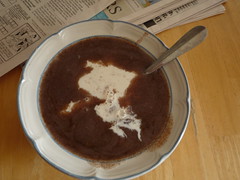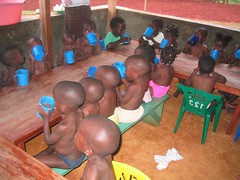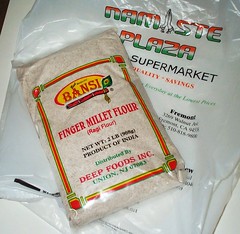 Uganda Porridge
Uganda Porridge Uganda Porridge
Uganda PorridgeWhen I was in Uganda, my host family almost didn't know what to make of the box of Koko Krunch Cereal that I brought home from the market one day. To them, breakfast usually means porridge, or hot cereal as we would call it in American English. They had familiar ones like rice porridge (cream of rice) and oat porridge (oatmeal), but there was another kind they had which they called "Millet Porridge".
 The first time I saw millet porridge I didn't know what to make of it. The helpers at the baby cottage said the toddlers were drinking their morning porridge--but its...brown? I'd never seen a brown "oatmeal" before. But at the pastor's house in Masaka a couple weeks later, Diana makes this same porridge, and sounding better than untoasted bread, I gave it a try and quickly gave it a thumbs up. You have to add a bit more sugar to it than you do to oatmeal since it isn't as naturally sweet of a grain, but it is more flavorful and actually more nutritious of a grain than oats or rice. Topped with milk and a sliced finger-banana, it makes a great breakfast.
The first time I saw millet porridge I didn't know what to make of it. The helpers at the baby cottage said the toddlers were drinking their morning porridge--but its...brown? I'd never seen a brown "oatmeal" before. But at the pastor's house in Masaka a couple weeks later, Diana makes this same porridge, and sounding better than untoasted bread, I gave it a try and quickly gave it a thumbs up. You have to add a bit more sugar to it than you do to oatmeal since it isn't as naturally sweet of a grain, but it is more flavorful and actually more nutritious of a grain than oats or rice. Topped with milk and a sliced finger-banana, it makes a great breakfast.
So after I'd returned to America, I started to have a craving for the Ugandan Porridge and began a quest to make it at home. Of course, walking into Safeway or Luckys, there's no such thing as "Millet Porridge", nor anything remotely close. The hot cereals aisle has cream of wheat, and oatmeal, and if you're lucky a mixed "five grain" or "seven grain" hot cereal.
 The proper American English term for the Millet cereal grain found in Uganda is either "Finger Millet" or "Ragi". What we call "millet" in America is a much more bland grain than the African variety. Finger Millet comes from a plant called "Eleusine coracana" that is native to Ethiopia (another East African country), and is mostly grown in Africa and India. It grows well in hot dry climates, and at high altitudes. In the 1800s it was introduced in the US, but it has generally fallen out of favor in the US for purposes other than bird or livestock feed. However, because it grows well in both India and Africa, it can easily be found at an ethnic foods store specializing in Indian food.
The proper American English term for the Millet cereal grain found in Uganda is either "Finger Millet" or "Ragi". What we call "millet" in America is a much more bland grain than the African variety. Finger Millet comes from a plant called "Eleusine coracana" that is native to Ethiopia (another East African country), and is mostly grown in Africa and India. It grows well in hot dry climates, and at high altitudes. In the 1800s it was introduced in the US, but it has generally fallen out of favor in the US for purposes other than bird or livestock feed. However, because it grows well in both India and Africa, it can easily be found at an ethnic foods store specializing in Indian food.
Finger millet seems to be a rather nutritious grain when you read about it. It is rich in calcium, and it contains Methionine, an amino acid our bodies cannot produce naturally that is also found in fish and meat. For poor people subsisting off staple foods of africa like plantains, rice, and maize, finger millet may be the only source of methionine in their diet. It has a higher amount of fiber than rice or wheat, and is also of value to diabetics because it has a lower glycemic response and "antinutritional" properties ("trypsin inhibitors, phytates, phenols and tannins") that reduce the starch absorption into the body.
Once you've found some finger millet flower, however, figuring out how to cook it properly is an entirely different matter. It's been a bit of an experiment to get this recipe right. Joyce's recipe called for taking three spoonfuls of millet flour, mixing with a small amount of cold water, and then pouring into boiling water and for ten minutes. Somewhere along the line you're supposed to add a pinch of salt. And after its cooked, typically it is poured into a thermos to keep warm until you are ready to eat, at which time you add sugar (the large grained cane or brown sugar would be the best matches) and milk (hot or cold depending on what's available).
Ingredients:
Directions:
But even done wrong, its still pretty good, so don't be too afraid to try it. Just don't try to "cheat" by cooking it in the microwave--it won't come out tasting good like it does cooked the old fashioned way. And as far as should you use a non-stick pot? Well, the Ugandans' don't. They use an inexpensive aluminum pot and it sticks like crazy (so add extra everything to compensate), but its a lot less work to clean up if you do use non-stick cookware!